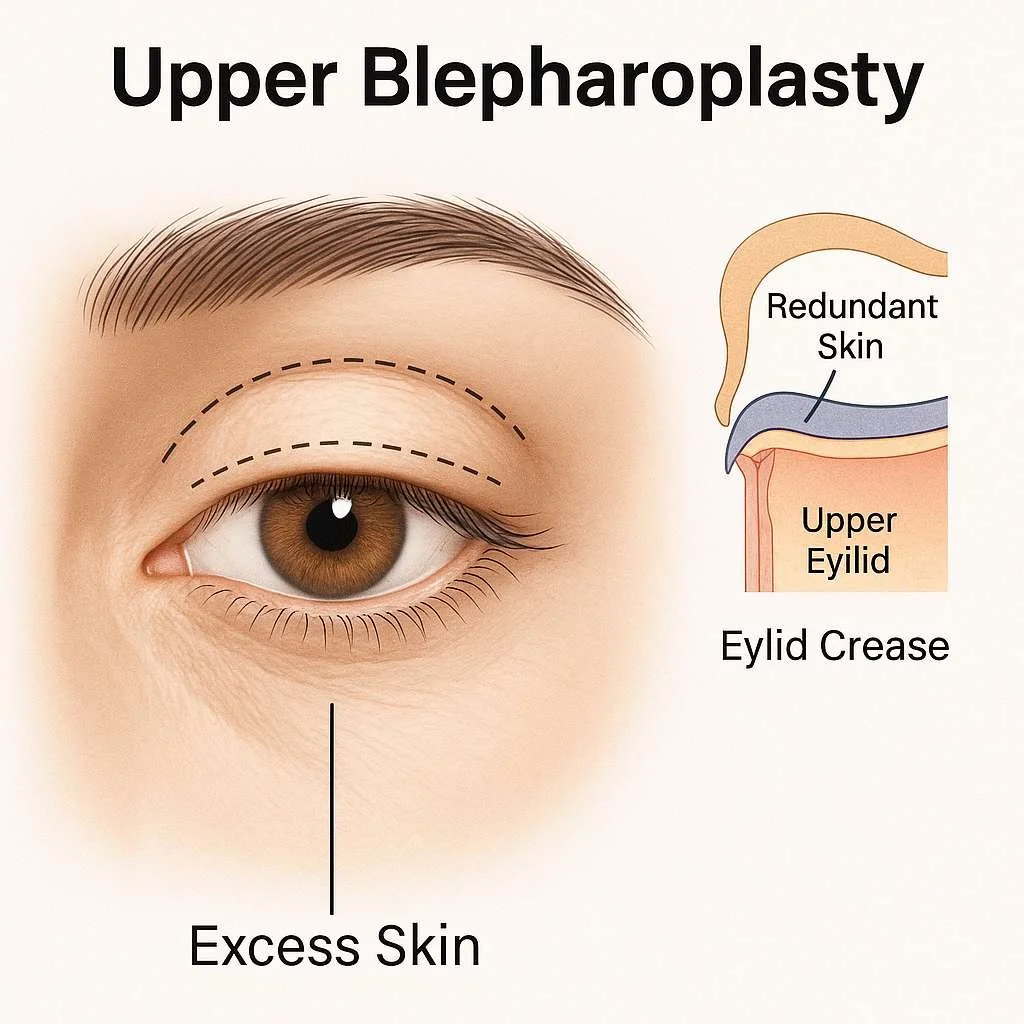How to Fix Droopy or Hooded Eyelids Without Looking “Done”
Many adults notice their eyelids beginning to sag as they age. For some, the change is subtle; for others, it affects both appearance and vision. While topical products or exercises promise improvement, stretched eyelid skin rarely tightens on its own. For lasting and natural results, the most effective solution is a carefully planned upper blepharoplasty, also called upper eyelid surgery.
Why Eyelids Lose Their Lift
The upper eyelid skin is thin and delicate. Over the years, collagen and elastin fibers break down, and the muscles that lift the lid may weaken. Genetics, sun exposure, smoking, and poor sleep accelerate this process. When the skin begins to fold over the lash line, it creates what is often called hooded eyes or droopy eyelids.
According to the Cleveland Clinic’s overview of eyelid anatomy (no-follow), this region contains fine structures that are sensitive to gravity and aging. Once the supportive tissue thins, the upper lid can obscure the natural crease and make the eyes appear smaller or tired.
When Surgery Becomes the Right Choice
If heavy skin interferes with your makeup routine or your field of vision, an upper blepharoplasty may be recommended. During this outpatient procedure, a board-certified plastic surgeon removes a small section of redundant skin and, when necessary, a slight amount of fat. The result is a smoother, more defined eyelid contour that still looks entirely your own.
At Adonis Plastic Surgery, upper eyelid surgery is performed in an accredited facility by experienced surgeons who specialize in precision facial rejuvenation. Each plan is tailored to the individual’s anatomy to ensure that the outcome appears refreshed rather than “done.”
Learn more about upper eyelid surgery (upper blepharoplasty) in Torrance and how the procedure can restore balance to the eyes while improving comfort and confidence.
This medical diagram illustrates the anatomy of the upper eyelid and the common area of excess skin addressed during upper blepharoplasty. It shows the natural eyelid crease, the redundant skin fold that can cause hooding, and the position of the underlying fat pad. The visual helps patients understand how a small, precisely placed incision restores a smooth eyelid contour without changing the eye’s natural shape.
Alternatives and Limitations
Mild laxity can sometimes be improved with non-surgical devices that use radiofrequency or plasma energy to tighten surface tissue. These approaches may provide a modest lift but cannot remove excess skin. Once the skin has stretched beyond a certain point, surgical correction offers the only long-term improvement.
A consultation with a qualified surgeon helps determine whether a conservative, non-invasive treatment is worthwhile or if a formal blepharoplasty will achieve a more predictable and lasting result.
How Natural-Looking Results Are Achieved
Successful outcomes depend on surgical precision and restraint. The surgeon maps the natural eyelid crease before removing any tissue, preserving the harmony between brow, lid, and lash line. The incision is hidden within the crease and typically fades to a nearly invisible line within a few weeks.
The American Society of Plastic Surgeons’ Eyelid Surgery Guide notes that most patients resume normal activities within ten days. Swelling and bruising are expected early on but diminish quickly with proper aftercare and follow-up.
What to Expect During Recovery
Recovery from upper eyelid surgery is generally straightforward. Cold compresses and head elevation help reduce swelling in the first few days. Patients are encouraged to avoid strenuous activity for about a week. Once cleared by the surgeon, light makeup can conceal any remaining discoloration until full healing occurs.
At Adonis Plastic Surgery, every patient receives detailed postoperative guidance and has direct access to the care team for questions. This personal attention supports both safety and confidence throughout the healing process.
Seeing Yourself Clearly Again
Upper blepharoplasty is more than a cosmetic enhancement. By removing heavy, overhanging skin, it can widen the visual field and bring light back to the eyes. Many patients describe looking more awake and feeling more energetic after recovery.
If sagging or hooded eyelids have been affecting your expression or daily comfort, consider scheduling a private consultation. Our team provides honest evaluations, realistic expectations, and customized recommendations based on medical need and aesthetic goals.


